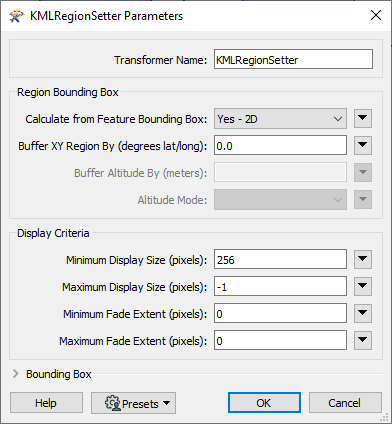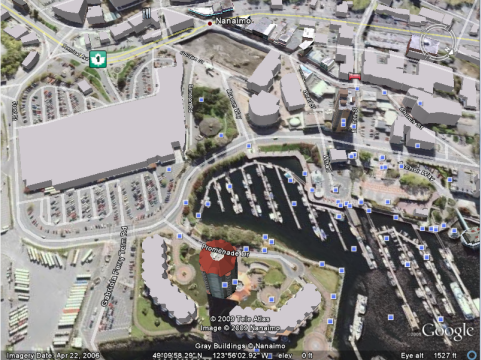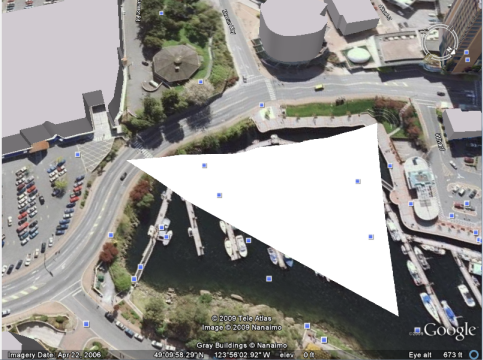Sets the region-related KML attributes for a group of features destined for the OGCKML Writer.
Example
The default settings will calculate a bounding box, and use that as the bounding box for the feature's region:

The inactive view shows that the feature is not initially displayed when you are zoomed out. The region is "inactive" and therefore the feature is not shown.

As you zoom in closer, the view meets the display criteria and the region activates; that is, the feature displays.

Usage Notes
For more information about KML regions and how Level of Detail is calculated:
- See the FME OGCKML Writer chapter in the FME Readers and Writers manual (in Workbench, select Help > FME Readers and Writers Reference)
- See the KML documentation: http://developers.google.com/kml/documentation/regions
Configuration
Parameters
|
Calculate from Feature Bounding Box |
This parameter specifies whether or not the bounding box of the region should be computed from the bounding box of the feature's geometry. If the value is Yes, the bounding box will be computed; if necessary, the calculated bounding box will be reprojected to the LL84 coordinate system. A valid coordinate system is required for the bounding box to be calculated. Note: Setting a value of Yes on point features is not recommended because they have no area and will generate an infinitely small bounding box. |
|
Buffer By |
This parameter is only available when the region bounding box is being calculated from the bounding box of the feature geometry. It may be used to make the bounding box of the KML region larger (or smaller) than the bounding box of the geometry. The geometry bounding box will be expanded (or decreased if the value is negative) on all sides, by the value of the parameter. The parameter value should be given in degrees of latitude/longitude. |
|
Minimum Display Size |
Minimum Pixels specifies the minimum size, in pixels, in the user's Google Earth view, that the region's bounding box must occupy before the region will become active – that is, when zooming in, at what point the feature should appear. The smaller the value, the sooner the feature will appear when zooming into the view. A value in the range of 256 to 512 is recommended. |
|
Maximum Display Size |
Maximum Pixels specifies the maximum size, in pixels, in the user's Google Earth view, that the region's bounding box may occupy before the region will be deactivated – that is, when zooming in, at what point the feature should disappear again. The smaller the value, the sooner the feature will disappear when zooming into the view. A value of -1 (infinite) is recommended. It means there is no maximum size and, once the feature has appeared, zooming in further will not cause it to disappear. |
|
Minimum Fade Extent |
This parameter specifies an offset to Minimum Pixels, in pixels, that determines the rate at which the region will be activated, and its contents displayed. A value of 0 (immediate transition) is recommended. |
|
Maximum Fade Extent |
This parameter specifies an offset to Maximum Pixels, in pixels, that determines the rate at which the region will be deactivated, and its contents hidden. A value of 0 (immediate transition) is recommended. |
|
Minimum X, Y/Maximum X, Y |
These parameters specify the coordinates, in the LL84 coordinate system, that define the boundary of the region's bounding box. |
Editing Transformer Parameters
Using a set of menu options, transformer parameters can be assigned by referencing other elements in the workspace. More advanced functions, such as an advanced editor and an arithmetic editor, are also available in some transformers. To access a menu of these options, click  beside the applicable parameter. For more information, see Transformer Parameter Menu Options.
beside the applicable parameter. For more information, see Transformer Parameter Menu Options.
Defining Values
There are several ways to define a value for use in a Transformer. The simplest is to simply type in a value or string, which can include functions of various types such as attribute references, math and string functions, and workspace parameters. There are a number of tools and shortcuts that can assist in constructing values, generally available from the drop-down context menu adjacent to the value field.
Using the Text Editor
The Text Editor provides a convenient way to construct text strings (including regular expressions) from various data sources, such as attributes, parameters, and constants, where the result is used directly inside a parameter.
Using the Arithmetic Editor
The Arithmetic Editor provides a convenient way to construct math expressions from various data sources, such as attributes, parameters, and feature functions, where the result is used directly inside a parameter.
Conditional Values
Set values depending on one or more test conditions that either pass or fail.
Parameter Condition Definition Dialog
Content
Expressions and strings can include a number of functions, characters, parameters, and more.
When setting values - whether entered directly in a parameter or constructed using one of the editors - strings and expressions containing String, Math, Date/Time or FME Feature Functions will have those functions evaluated. Therefore, the names of these functions (in the form @<function_name>) should not be used as literal string values.
| These functions manipulate and format strings. | |
|
Special Characters |
A set of control characters is available in the Text Editor. |
| Math functions are available in both editors. | |
| Date/Time Functions | Date and time functions are available in the Text Editor. |
| These operators are available in the Arithmetic Editor. | |
| These return primarily feature-specific values. | |
| FME and workspace-specific parameters may be used. | |
| Creating and Modifying User Parameters | Create your own editable parameters. |
Dialog Options - Tables
Transformers with table-style parameters have additional tools for populating and manipulating values.
|
Row Reordering
|
Enabled once you have clicked on a row item. Choices include:
|
|
Cut, Copy, and Paste
|
Enabled once you have clicked on a row item. Choices include:
Cut, copy, and paste may be used within a transformer, or between transformers. |
|
Filter
|
Start typing a string, and the matrix will only display rows matching those characters. Searches all columns. This only affects the display of attributes within the transformer - it does not alter which attributes are output. |
|
Import
|
Import populates the table with a set of new attributes read from a dataset. Specific application varies between transformers. |
|
Reset/Refresh
|
Generally resets the table to its initial state, and may provide additional options to remove invalid entries. Behavior varies between transformers. |
Note: Not all tools are available in all transformers.
FME Community
The FME Community is the place for demos, how-tos, articles, FAQs, and more. Get answers to your questions, learn from other users, and suggest, vote, and comment on new features.
Search for samples and information about this transformer on the FME Community.
Keywords: "Google Earth" KML




